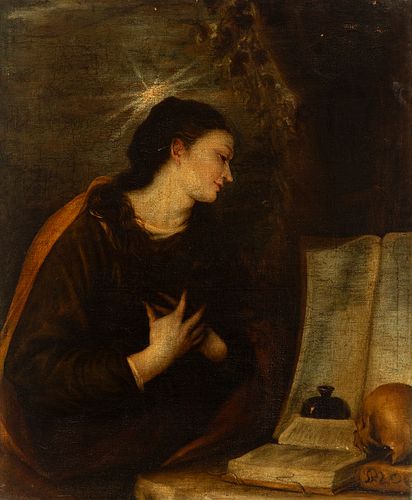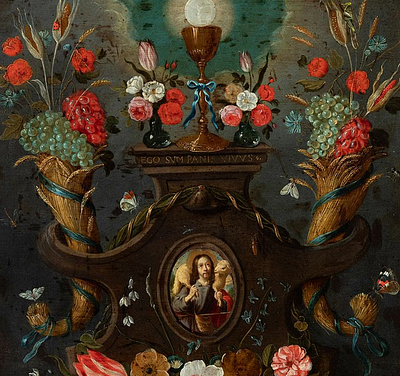Circle of MATEO CEREZO (Burgos, 1637-Madrid, 1666). "Penitent Magdalene". Oil on canvas. Relining. It presents repainting and restorations.
Lot 41
About Seller
Setdart Auction House
Carrer Aragó 346
Barcelona
Spain
Setdart Subastas was born in 2004 and is currently the first online art auction in Spain with solidity, prestige and reliability guaranteed by our more than 60,000 users. Setdart has a young, dynamic and enterprising team ready to successfully manage the purchase and sale of art works through custom...Read more
Estimate:
EUR€4,000 - EUR€5,000
$4,210.53 - $5,263.16
Absentee vs Live bid
Two ways to bid:
- Leave a max absentee bid and the platform will bid on your behalf up to your maximum bid during the live auction.
- Bid live during the auction and your bids will be submitted real-time to the auctioneer.
Bid Increments
| Price | Bid Increment |
|---|---|
| EUR€0 | EUR€10 |
| EUR€200 | EUR€25 |
| EUR€500 | EUR€50 |
| EUR€1,000 | EUR€100 |
| EUR€3,000 | EUR€200 |
| EUR€5,000 | EUR€500 |
| EUR€10,000 | EUR€1,000 |
| EUR€20,000 | EUR€2,000 |
| EUR€50,000 | EUR€5,000 |
About Auction
By Setdart Auction House
Sep 21, 2021
Set Reminder
2021-09-21 10:00:00
2021-09-21 10:00:00
America/New_York
Bidsquare
Bidsquare : 21st September - ARAS JÁUREGUI Private Collection - Old Masters, 19th & 20th Century
https://www.bidsquare.com/auctions/setdart-auction-house/21st-september---aras-j-uregui-private-collection---old-masters-19th-20th-century-7429
Setdart Auction House sofia@setdart.com
Setdart Auction House sofia@setdart.com
- Lot Description
Circle of MATEO CEREZO (Burgos, 1637-Madrid, 1666). "Penitent Magdalene". Oil on canvas. Relining. It presents repainting and restorations. Measurements: 103 x 85 cm. In this canvas, Mary Magdalene is represented as a penitent in the desert, dressed with a jet robe, on which the red tone of the cloak stands out. Although this is an unusual feature, the young woman, who appears to be absorbed in the Scriptures, does not have long, flowing hair, which alludes to the style of the young woman's life before she met Christ. The saint is depicted next to a perfumer, the Holy Scriptures and the skull. Mary Magdalene is mentioned in the New Testament as a distinguished disciple of Christ. According to the Gospels, she housed and provided materially for Jesus and his disciples during their stay in Galilee, and was present at the Crucifixion. She was a witness to the Resurrection, as well as the one in charge of transmitting the news to the apostles. She is also identified with the woman who anointed the feet of Jesus with perfumes before his arrival in Jerusalem, so her main iconographic attribute is a knob of essences, like the one shown here. While Eastern Christianity particularly honours Mary Magdalene for her closeness to Jesus, considering her "equal to the apostles", in the West the idea developed, based on her identification with other women in the Gospels, that before meeting Jesus she had engaged in prostitution. Hence the later legend that she spent the rest of her life as a penitent in the desert, mortifying her flesh. She was most often depicted in this way in art, especially in the 17th century, a time when Catholic societies were particularly fascinated by the lives of mystics and saints who lived in solitude in the wilderness, dedicated to prayer and penance. The story of this saint serves as an example of Christ's forgiveness, and conveys the message of the possibility of redemption of the soul through repentance and faith. Mateo Cerezo trained in Madrid, where he joined Carreño's workshop. He was in great demand by a varied clientele, particularly for his religious painting, although he also tackled other genres. In this respect, the treatise writer and biographer Palomino stated that he produced "still lifes with such superior excellence that no one else could surpass him", a judgement that is fully corroborated by the works in the Museo Nacional de San Carlos in Mexico, which are signed and dated. On the basis of these, Pérez Sánchez attributed to him the Kitchen Still Life purchased by the Museo del Prado in 1970, a work of evident Flemish influence that has sometimes led him to think of Pereda. The work of this artist from Valladolid has also been identified as Cerezo's descendant, particularly in his early creations. We know that in 1659 Cerezo was working in Valladolid, where he left somewhat rougher works than those he produced in the following decade. In his works he is a faithful follower of Carreño, with whom he became one of his best collaborators. The master showed him the path he himself later followed, following in the footsteps of Van Dyck and Titian. Thus, Cerezo developed compositions that open out into large, complex scenographies, conceived with a distinguished refinement that is evident both in the work as a whole and in the smallest details. Like the Antwerp master, he endowed his figures with a rich magnificence in their costumes, applying a fluid, light brushstroke, contrasted by a rich play of light. A superb example of all this is the Prado's The Mystical Betrothal of Saint Catherine, signed and dated 1660.
- Shipping Info
-
In-house shipping available. Please inquire at admin@setdart.com.
-
- Buyer's Premium



 EUR
EUR CAD
CAD AUD
AUD GBP
GBP MXN
MXN HKD
HKD CNY
CNY MYR
MYR SEK
SEK SGD
SGD CHF
CHF THB
THB
















